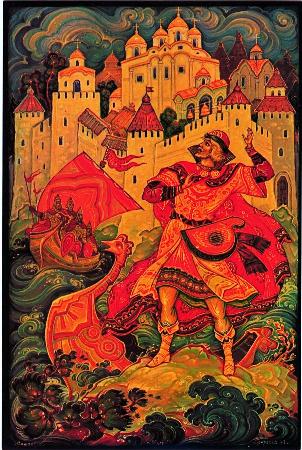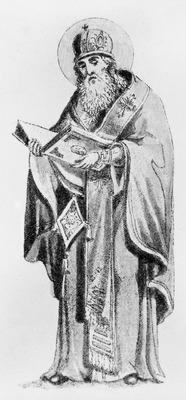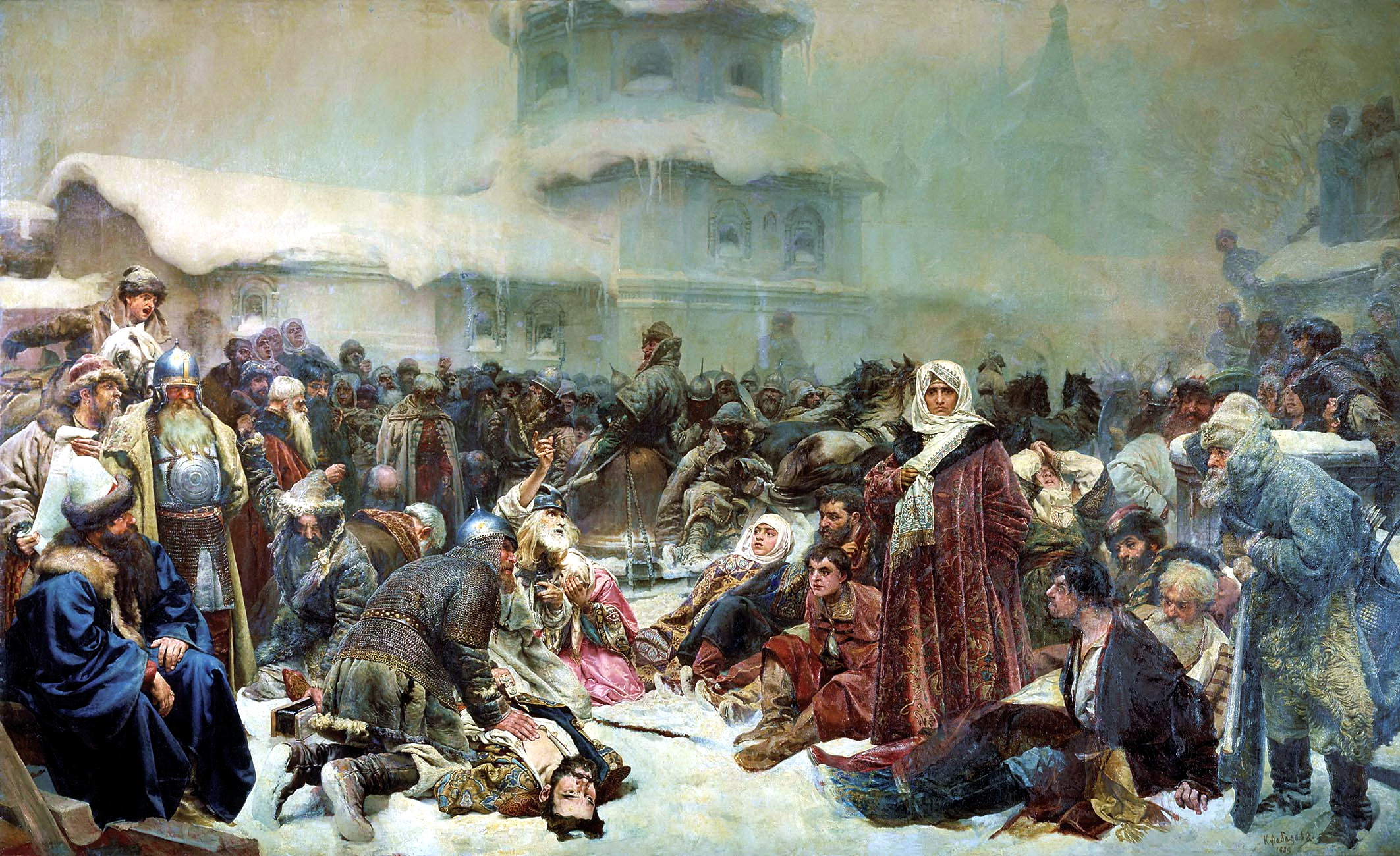|
Novgorod Kremlin
The Novgorod Detinets (russian: Новгородский детинец, Novgorodskiy detinets), also known as the Novgorod Kremlin (, ''Novgorodskiy kreml' ''), is a fortified complex (detinets) in Veliky Novgorod, Russia. It stands on the left bank of the Volkhov River about two miles north of where it empties out of Lake Ilmen. History The compound was originally the site of a pagan burial ground upon which the first bishop of Novgorod, Ioakim Korsunianin, built the Cathedral of Holy Wisdom upon his arrival in the area in 989 or so. Thus the compound was and remained largely an ecclesiastical site, although many Novgorodian boyars built their houses in the southern part of the Detinets. The first reference of the fortification on the site dates to 1044, with additional construction taking place in 1116. These were probably earthen embankments topped by a wooden palisade, although stone towers and walls were built in 1302. Archbishop Vasily Kalika (1330–1352) rebuilt the ... [...More Info...] [...Related Items...] OR: [Wikipedia] [Google] [Baidu] |
Veliky Novgorod
Veliky Novgorod ( rus, links=no, Великий Новгород, t=Great Newtown, p=vʲɪˈlʲikʲɪj ˈnovɡərət), also known as just Novgorod (), is the largest city and administrative centre of Novgorod Oblast, Russia. It is one of the oldest cities in Russia, being first mentioned in the 9th century. The city lies along the Volkhov River just downstream from its outflow from Lake Ilmen and is situated on the M10 federal highway connecting Moscow and Saint Petersburg. UNESCO recognized Novgorod as a World Heritage Site in 1992. The city has a population of At its peak during the 14th century, the city was the capital of the Novgorod Republic and was one of Europe's largest cities. The "Veliky" ("great") part was added to the city's name in 1999. History Early developments The Sofia First Chronicle makes initial mention of it in 859, while the Novgorod First Chronicle first mentions it in 862, when it was purportedly already a major Baltics-to- Byzantium statio ... [...More Info...] [...Related Items...] OR: [Wikipedia] [Google] [Baidu] |
Vasily Kalika
Vasilii Kalika (russian: Василий Калика) was Archbishop of Novgorod the Great and Pskov from 1330 to 1352. He is in large part responsible for reinvigorating the office after it had fallen into decline to some extent following the Mongol Invasion. Background His baptismal name was originally Grigorii and he had been a priest of the Church of Cosmas and Damian on Slave Street north of the Detinets in Novgorod before his archiepiscopate. The name Kalika means "pilgrim" in Russian (there is another word, Palomnik) and indicates that he made a pilgrimage to the Holy Land sometime prior to his archiepiscopate. He, in fact, mentions this in a famous letter he wrote to Bishop Fedor of Tver' in 1347 which has been inserted into two Russian chronicles, the '' Sofia First Chronicle'' and the ''Novgorod Second Chronicle''. In one redaction of the ''Novgorodian First Chronicle'', he is referred to as Kaleka (rather than Kalika, chu, Калѣка), a word meaning "lame" or " ... [...More Info...] [...Related Items...] OR: [Wikipedia] [Google] [Baidu] |
Historic Monuments Of Novgorod And Surroundings
Historic Monuments of Novgorod and Surroundings is a composite World Heritage Site which includes a number of medieval monuments in and around Veliky Novgorod, Russia. The site was inscribed in 1992. History Novgorod between the 9th and the 15th centuries was one of the most significant cities of medieval Rus. It lay on the trade route from the Varangians to the Greeks and was the center of the Novgorod Republic, which included the major part of what is currently northwestern Russia. From the 12th century, it was an example of a medieval republic, in which decisions were taken by veche – a meeting of the city population – and the prince was elected. (The only other Russian city with a similar organization was Pskov.) Novgorod was one of few areas of Rus not affected by the Mongol invasions, and therefore, in particular, active ecclesiastical construction was continuing in Novgorod in the 14th century, while it was stale in the rest of Rus. Novgorod was as well the seat of arch ... [...More Info...] [...Related Items...] OR: [Wikipedia] [Google] [Baidu] |
Banknote 5 Rubles (1997) Back
A banknote—also called a bill (North American English), paper money, or simply a note—is a type of negotiable promissory note, made by a bank or other licensed authority, payable to the bearer on demand. Banknotes were originally issued by commercial banks, which were legally required to redeem the notes for legal tender (usually gold or silver coin) when presented to the chief cashier of the originating bank. These commercial banknotes only traded at face value in the market served by the issuing bank. Commercial banknotes have primarily been replaced by national banknotes issued by central banks or monetary authorities. National banknotes are often – but not always – legal tender, meaning that courts of law are required to recognize them as satisfactory payment of money debts. Historically, banks sought to ensure that they could always pay customers in coins when they presented banknotes for payment. This practice of "backing" notes with something of substance is t ... [...More Info...] [...Related Items...] OR: [Wikipedia] [Google] [Baidu] |
German-Soviet War
The Eastern Front of World War II was a theatre of conflict between the European Axis powers against the Soviet Union (USSR), Poland and other Allies, which encompassed Central Europe, Eastern Europe, Northeast Europe (Baltics), and Southeast Europe (Balkans) from 22 June 1941 to 9 May 1945. It was known as the Great Patriotic War in the Soviet Union – and still is in some of its successor states, while almost everywhere else it has been called the ''Eastern Front''. In present-day German and Ukrainian historiography the name German-Soviet War is typically used. The battles on the Eastern Front of the Second World War constituted the largest military confrontation in history. They were characterised by unprecedented ferocity and brutality, wholesale destruction, mass deportations, and immense loss of life due to combat, starvation, exposure, disease, and massacres. Of the estimated 70–85 million deaths attributed to World War II, around 30 million occurred on t ... [...More Info...] [...Related Items...] OR: [Wikipedia] [Google] [Baidu] |
Sadko
Sadko (russian: Садко) is the principal character in a Russian medieval epic ''bylina''. He was an adventurer, merchant, and ''gusli'' musician from Novgorod. Textual notes "Sadko" is a version of the tale translated by Arthur Ransome in ''Old Peter's Russian tales'' (1916). Kate Blakey's translation of a variant, "Sadko, the Rich Merchant Guest", appeared in the ''Slavonic Review'' (1924). A bylina version collected by P. N. Rybnikov has been translated by James Bailey. Synopsis Sadko of Novgorod played the ''gusli'' on the shores of a lake and river. The Tsar of the Sea enjoyed his music, and offered to help him. Sadko was instructed to make a bet with the local merchants about catching a gold-finned fish in the lake; when he caught it (as provided by the Sea Tsar), the merchants had to pay the wager, making Sadko a rich merchant. Sadko traded on the seas with his new wealth, but did not pay proper respects to the Tsar as per their agreement. The Tsar stopped Sadk ... [...More Info...] [...Related Items...] OR: [Wikipedia] [Google] [Baidu] |
Millennium Of Russia
The Millennium of Russia (russian: Тысячелетие России, Tysyacheletiye Rossii) is a bronze monument in the Novgorod Kremlin. It was erected in 1862 to celebrate the millennium of Rurik's arrival to Novgorod, an event traditionally taken as a starting point of the History of Russia, history of Russian statehood. History A competition to design the monument was held in 1859. An architect Viktor Hartmann and an artist Mikhail Mikeshin were declared the winners. Mikeshin's design called for a grandiose, 15-metre-high ''globus cruciger'' on a bell-shaped pedestal. It was to be encircled with several tiers of sculptures representing Russian monarchs, clerics, generals, and artists active during various periods of Russian history. Mikeshin himself was not sculptor, therefore the 129 individual statues for the monument were made by the leading Russian sculptors of the day, including his friend and the promising new sculptor, Alexander Opekushin. Rather unexpectedly ... [...More Info...] [...Related Items...] OR: [Wikipedia] [Google] [Baidu] |
Gennady (Archbishop Of Novgorod)
Gennadius (Gennady, russian: Геннадий; died 4 December 1505) was Archbishop of Novgorod the Great and Pskov from 1484 to 1504. He was most instrumental in fighting the Heresy of the Judaizers and is famous for compiling the first complete codex of the Bible in Slavic in 1499, known as the Gennady Bible. Gennady is a saint of the Russian Orthodox Church. His feast day is 4 December OS/17 December in the Gregorian Calendar. Biography Gennady was from the Gonzov boyar clan of Moscow and was, prior to his archiepiscopate, hegumen of the Chudov Monastery in the Moscow Kremlin. His immediate predecessor in Novgorod, Sergei, served less than a year. Sergei was recalled and confined to the Chudov Monastery apparently due to mental illness. Gennady was named Archbishop of Novgorod in Moscow and placed in office on 12 December 1484, the first Novgorodian prelate not chosen by lots since 1359. He arrived in Novgorod in January 1485 with the task (as had been Sergei's) of bring ... [...More Info...] [...Related Items...] OR: [Wikipedia] [Google] [Baidu] |
Ivan III Of Russia
Ivan III Vasilyevich (russian: Иван III Васильевич; 22 January 1440 – 27 October 1505), also known as Ivan the Great, was a Grand Prince of Moscow and Grand Prince of all Rus'. Ivan served as the co-ruler and regent for his blind father Vasily II from the mid-1450s before he officially ascended the throne in 1462. He multiplied the territory of his state through war and through the seizure of lands from his dynastic relatives, ended the dominance of the Tatars over Russia, renovated the Moscow Kremlin, introduced a new legal codex and laid the foundations of the Russian state. His 1480 victory over the Great Horde is cited as the restoration of Russian independence, 240 years after the fall of Kiev in the Mongol invasion of Kievan Rus'. Ivan was the first Russian ruler to style himself " tsar", albeit not as an official title. Through marriage to Sofia Paleologue, he made the double-headed eagle Russia's coat of arms and adopted the idea of Moscow as ... [...More Info...] [...Related Items...] OR: [Wikipedia] [Google] [Baidu] |
Grand Duchy Of Moscow
The Grand Duchy of Moscow, Muscovite Russia, Muscovite Rus' or Grand Principality of Moscow (russian: Великое княжество Московское, Velikoye knyazhestvo Moskovskoye; also known in English simply as Muscovy from the Latin ) was a Rus' principality of the Late Middle Ages centered on Moscow, and the predecessor state of the Tsardom of Russia in the early modern period. It was ruled by the Rurik dynasty, who had ruled Rus' since the foundation of Novgorod in 862. Ivan III the Great titled himself as Sovereign and Grand Duke of All Rus' (russian: государь и великий князь всея Руси, gosudar' i velikiy knyaz' vseya Rusi). The state originated with the rule of Alexander Nevsky of the Rurik dynasty, when in 1263, his son, Daniel I, was appointed to rule the newly created Grand Principality of Moscow, which was a vassal state to the Mongol Empire (under the " Tatar Yoke"), and which eclipsed and eventually absorbed its parent du ... [...More Info...] [...Related Items...] OR: [Wikipedia] [Google] [Baidu] |
Brick Gothic
Brick Gothic (german: Backsteingotik, pl, Gotyk ceglany, nl, Baksteengotiek) is a specific style of Gothic architecture common in Northeast and Central Europe especially in the regions in and around the Baltic Sea, which do not have resources of standing rock, but in many places many glacial boulders. The buildings are essentially built using bricks. Buildings classified as Brick Gothic (using a strict definition of the architectural style based on the geographic location) are found in Belgium (and the very north of France), Netherlands, Germany, Poland, Lithuania, Latvia, Estonia, Kaliningrad (former East Prussia), Denmark, Sweden and Finland. As the use of baked red brick arrived in Northwestern and Central Europe in the 12th century, the oldest such buildings are classified as the Brick Romanesque. In the 16th century, Brick Gothic was superseded by Brick Renaissance architecture. Brick Gothic is characterised by the lack of figurative architectural scul ... [...More Info...] [...Related Items...] OR: [Wikipedia] [Google] [Baidu] |
_back.jpg)







